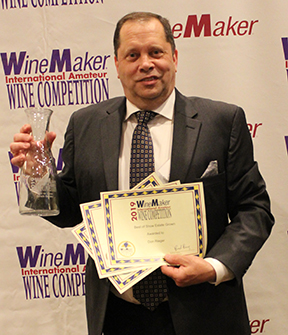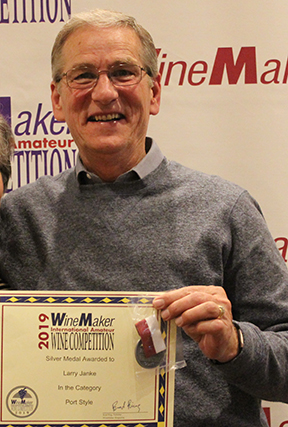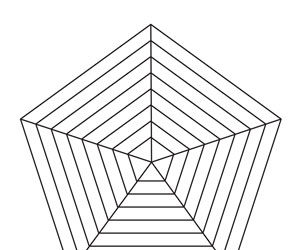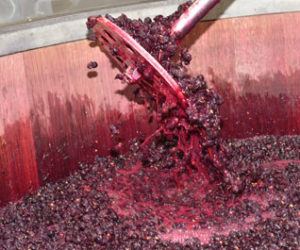While none of the three panelists for this “Tips from the Pros” column are actually pros, their knowledge is second to none. We’ve accumulated three “Best of Show” winners from the 2019 WineMaker International Amateur Wine Competition to share their medal-winning advice.

Kathleen Ondrus, Winemaker of the Year and Grand Champion Wine at the WineMaker International Amateur Wine Competition in 2018 and 2019.
My Grand Champion Wine is a 2018 Muscat Canelli grown here in the Grand Valley AVA of Colorado. I source my grapes from several growers here in the Grand Valley but this grape was sourced through Talbot Farms, where they cool the grapes in their massive coolers until they are picked up and I have the time to process them. The grapes were medium sized, green in color with some sunburned skins. No mold or off odors were noted. Seeds brown with yellow centers. Liquid centers that do not hold onto seeds. Juice tart and sweet between granny smith and honey crisp with a nose of granny smith apples. Skins mellow flavor with no bitterness. Seeds were hard with good tannin structure.
My 400 lbs. (181 kg) of grapes were crushed/destemmed adding Lafase press at a ratio of 5 gm/100 kg and 30 ppm potassium metabisulfite (KMBS) during crush. They were pressed immediately with minimal skin contact in my bladder press. The juice was then placed in plastic fermenters in a temperature-controlled freezer chest for 24 hours at 34 °F (1 °C).
The next day the clear juice is racked off the sediment. Six gallons (23 L) taken for making wine and the rest was frozen for the use of icewine and concentrate for backsweetening (more on this later). A sample of the juice analyzed with the following: pH 3.53 (would like it a little lower for microbial stability), TA 5.16 (would like it around 7.0 g/L to 7.5 g/L) Brix 24.5 (Percent alochol 14.21–15.19 which is good for what I want because I backsweeten, which will lower the ABV), SG 1.1032, Alpha Amino 116.1, Ammonia 94, and YAN 193.42.
Since I am making a sweeter wine, I first wanted to adjust my acid to around 7.0 g/L so I adjusted my juice using tartaric acid at 1.84 gm/L for my 6-gallon (23-L) batch (total addition of 41.79 g) and left it at 64 °F (18 °C) to slowly warm up.
I used Laffort VL1 yeast (a high nutrient requirement and likes fermentation temperatures of 61–68 °F/16–20 °C). Using the Laffort protocol, 8.44 gm GoFerm was added to 136.3 mL water at 110 °F (43 °C). When the water cooled to 98 °F (37 °C), 6.8 g yeast was added and after 20 minutes it was added to the juice.
I added approximately 5.5 g of Fermaid K after the 24 hours, and 5 g of DAP the four days later with the Brix at 15. A week later I racked off gross lees and added 40 ppm KMBS for a pH of 3.41.
In February I performed back sweetening tasting trials. I use concentrate using the juice from the press of this grape. I like this because I feel I preserve the flavors of the grape without adding a lot of water. I settled on a ratio of 50 mL finished wine to 35 mL concentrate. Potassium sorbate was added at ½ tsp to the gallon.
Five days later I performed finishing trials. The wine was a little flabby (lacking acid) and a little too spicy for me so I did some finishing trials of acid (tartaric/malic/citric) additions and finishing tannins. I liked the citric acid trial of 1.8 g/L addition and the addition of finishing tannins at 60 mg/L.
Three weeks later I did fining trials with 3 lbs/Kgal Bentonite (8.1 g for 6 gallons/23 L) addition for heat stabilization. However due to the deadline for the competition, it was not added until after the competition bottle was sent. It was then put back in my temp-controlled freezer for cold stabilization.
Every year, I try to do just one thing different to try and improve my wine. This year I did a few things different. Last year I let the must sit on the skins for approximately 12 hours, but this year I eliminated the skin contact. I also adjusted my acid levels before starting my fermentation process, which reduced my post-fermentation acid adjustment this year. The last thing I did different was adding finishing tannins. I did several trials and really liked how they made the wine softer and brought out better fruit qualities.
I have never known any winemakers, so the feedback from the judges is invaluable! Friends and family always tell me how good my wine is but I am not sure if they are being honest or just being nice. Every year after I get my notes back, I try to pick out one fault to try and improve (already have plans for next year). First year was SO2, so I learned about SO2. Next year, wine was “out of balance,” so I learned what that meant and worked on it! This year was about making dry whites, icewines, and tweaking what I had down! Every year I also try to challenge myself with a new wine, or two, or three!
While the judging feedback is invaluable, I would suggest to others not to look at the judges notes and take it personally (sometimes I wonder if the judges are tasting the same wine because they can be so different from each other!), learn from them. Never stop trying to improve. Just because you think your wine is great does not mean it couldn’t be even better!
Making my own concentrate: After I have crush/destemmed/pressed and separated the juice from the sediment, I put approximately 4 gallons of juice in a 5-gallon bucket. I freeze this for 24 hours. In 24 hours, I take the bucket out of the freezer and poor the liquid concentrate in the center into a separate bucket and then lay what is left of the juice on its side to let the rest of the concentrate drip out. When my concentrate gets down to 25 °Brix, I make a cut off. I learned to use plastic sheeting on the floor and keep the bucket elevated just barely above the receiving bucket using a cart to reduce the splatter all over the floor (what a sticky mess). (Water freezes before the high sugar concentrated juice pushing the concentrate towards the middle, this is why this method works.)

Don Rieger won Best of Show Estate Grown for his 2018 La Crescent at the 2019 WineMaker International Amateur Wine Competition.
Three years ago we planted 100 plants of La Crescent and Frontenac Blanc (in addition to the Concord, Niagara, Catawba, Marquette, and Frontenac that were previously planted). In 2018 we had our first harvest of La Crescent and Frontenac Blanc. Our yield for La Crescent was a bit low due to being the first-year harvest, though this is fairly normal. La Crescent is susceptible to downy mildew and Asian beetles.
Cold climate hybrids are an excellent choice for our vineyard. The surrounding vineyards in our area have really increased the amount of cold climate hybrids. We would like to transition from primarily native grapes to more of a focus on these hybrids. In order to successfully transition to growing the hybrids we had to first deter the birds that wiped out our first year’s crop of Marquette and Frontenac. So the following year we netted our entire crop of hybrids. We also have an ongoing challenge of dealing with the low pH and acid levels in the grapes.
I have been making wine from native grapes since I was 16. So over the past two years I really had to step up my knowledge on how to manage low pH and high acid wines. To this end, three years ago I went to Chik Brenneman’s Boot Camp “Home Laboratory Testing” at the WineMaker conference in Cornell. We purchased some lab equipment for the vineyard shortly afterwards. I also joined the Minnesota Wine Producer Association (MWPA), which has phenomenal online resources for cold-climate grapes and winemaking. Within months of joining (MWPA) I was invited to attend the Iowa Wine Producer Conference. I attended many breakout classes at the conference and met some amazing people . I started to network and met the most helpful and giving person, Michael White, an Iowa State University Extension representative. Meeting Michael White was the catalyst to the making of my La Crescent wine.
This year I attended a Wine Chemistry class at Kent State Ashtabula as well as the Ohio Wine Producers conference in Columbus. I have read countless books and online resources. Though I have worked for the past 12 years as an RN at the Cleveland Veterans Affairs Medical Center, I believe it is my culinary skills that give me an edge with regard to winemaking. I am a classically trained chef and graduated from The Culinary Institute of America in 1983. As a chef I have a pretty keen sense of taste and have tasted many fine wines over my 30-year career. Now that I have gathered an arsenal of information and honed my skills as a chef, I am hoping to make even better wine using only Ohio grapes, particularly these cold climate hybrids.
My 2018 La Crescent grapes that won Best of Show Estate-Grown were harvested at 24 °Brix, acid 13 g/L, pH 3.09, ABV 12%, and the wine finished with less than 1% residual sugar. No special adjustments were made with the La Crescent. My challenge for next year is not only dealing low Ph and high acid but to bring out more aroma from the La Crescent and Frontenac Blanc.
One thing that I think really helped make the La Crescent great was the use of the same yeast that I used for our native grapes, Red Star Montrachet, now called Premier Classique. This yeast tends to stop fermenting at about 12% alcohol, which helped keep some residual sugar, enhancing the citrus and tropical fruit notes. The Red Montrachet yeast is what I used last year for the Gold Medal I won for our Native American grape blend.
I didn’t set any expectations for this wine when entering it into competition. While I was working with this wine during racking and tasting, I just really hoped everyone who tastes the wine enjoys it and recognizes the uniqueness of this particular wine.
I ask friends and family to taste my wines and I do rely on my keen sense of taste. But my biggest inspiration for this La Crescent was meeting and tasting Illinois wine legend Chris Lawlor White’s La Crescent at the Gelena Winery in Gelena, Illinois. Michael White (no relation to Chris White) at the Iowa Wine Conference told me to go see and meet Chris White on my way back home to Ohio. He explained she is a phenomenal winemaker and she has many of the hybrid grape variety that I wanted to make wine from and that we had planted in a vineyard. Chris was so very gracious showing me her vineyard and winery. She was very excited when I mentioned we planted La Crescent. She invited me to taste the La Crescent, sharing that it was their first year for the variety and had just finished bottling it. I had never tasted La Crescent wine before and had no idea what it was going to taste like. I tasted it and was blown away! That was the start in making our La Crescent wine.

Larry Janke won Best of Show Kit Wine for his RJS Craft Winemaking Cru Specialty Coffee Dessert Wine at the 2019 WineMaker International Amateur Wine Competition.
The kit I entered was the RJS Cru Specialty Coffee Dessert Wine — a seasonal item available only by special order. I started the kit in May of 2018, so it was just shy of a year old when it was judged for the 2019 WineMaker International Amateur Wine Competition. From the feedback that I had been given on this wine from family, friends, and members of my wine club, I was very optimistic that it would be a high scoring wine. I was quite awestruck that it was judged Best of Show.
I started making wine many years ago, but have only been making wine from kits for about the past 10 years. So far, my spreadsheet shows over 125 kits completed in that timeframe. Many of those kits have been dessert wines, but they had previously always been the tried-and-true chocolate raspberry varieties. This was my first time making this specific kit. I thought I would step out of the main stream and see how this kit would compare.
I follow kit instructions quite carefully because of some mishaps I have experienced in the past. I know that the manufacturers have done the research to create a good drinkable wine. A person can be successful as long as all of the equipment is sanitary, and you keep the wine from heat, light, vibration, and oxidization.
I did treat this wine a little differently than my previous dessert wines. After the wine was complete, and the instructions say it is ready to bottle, that is where the magic had to happen. I filtered my wine, then waited a few days and tested it for SO2 and pH. I let this wine sit another 30 days to age before I bottled it to make sure that it was properly degassed. I have also upgraded to better corks and have seen a dramatic difference in a positive aging process.
Any wine that I am considering for competition needs to be aged and cellared properly first. When it is time to enter the wine, I will open a bottle to make sure it has no cork taint, is balanced, and ready to drink. I will often score it myself using the UC-Davis 20 point system. If it is good to go, I will open a second bottle, test that one as well, and if that one is good too, it can be used to top up the first bottle, then re-corked. I use argon to purge oxygen first. I make sure to do these tests and send in the wine at least 30 days before it is judged to avoid any chance of bottle shock.
Getting feedback from judges and other winemakers has been very important to my success as a winemaker. The first wine kits that I had entered into competitions were judged as too young, out of balance, not cleared properly, having too much CO2, or flawed in some other way. I have entered county fairs, the State Fair, and our own Purple Foot Wine Club annual competitions. I use the feedback because the judges will be specific as to the flaw or balance issues. Simply checking and adjusting acidity, balance, aroma, and clarity before bottling can make the difference between a drinkable wine and a gold medal winner. This Coffee Dessert Wine Kit has been a favorite of my family and friends since last Thanksgiving.




